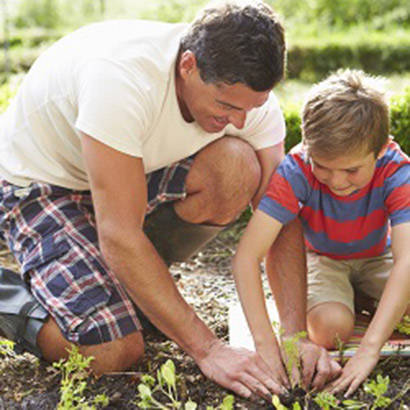
Lincoln’s Parks and Recreation Department’s community gardening program has grown rapidly from one location seven years ago to eight locations, including two new sites this year. One garden is designated for adults with traumatic brain injury, other disabilities, or mental illness and is used not only for recreation and exercise but also as a form of therapy. The other seven gardens are youth-designated. Most of the youth gardens serve both elementary- and middle-school children. However, one garden serves children from elementary through high school, and several gardens are specific to either elementary or middle school. The gardens are located at recreation centers, schools, and on land provided by local businesses and churches. Eighty to 90% of participating children are ethnic minorities, from low income houses, or are new Americans. Many of whom are from Sudan, Russia, and other countries in Asia. Since the program received its NPRA grant, it has served 472 children and 25 adults with disabilities, for a total of nearly 500 people.
One of the main goals of the youth gardening program is to help children understand the garden-to-table cycle. Sandy Myers, Recreation Manager and Kathryn Burklund, Program Monitor, both believe that it is important for children to understand not only what they are doing but why they are doing it every step of the way. This intentionality in teaching gardening skills, they feel, will ultimately lead to children feeling a greater sense of responsibility for the garden and getting more gratification from their efforts. In addition, children learn how they and their families can grow their own food, even in small containers on their balcony. Finally, children and their families learn that fresh produce can be affordable, even on a limited budget.
In addition to maintaining the vegetable garden, the children also planted apple trees. Garden-related field trips are included in the program as well. As Ms. Myers noted, “… the kids really get a full experience. They get to go into the vegetable garden and fruit areas, the tree areas, and [there are] a lot of experiences for the kids there.”
The produce is used for the children’s snacks or is sold at the program’s weekly youth farmers’ market. Produce from the youth gardens is taken to the market site and prepared for selling. The kids also take turns working at the market. Anything that is not eaten or sold is sent home with the children along with recipes.
The youth garden is a year-round activity, from planning the garden and planting seedlings indoors in the winter months through the fall harvest. Environmental education goes on all year. During the school year, the program is part of after-school programs, and in the summer, it is integrated into day-camps located at city recreation centers.
The program has developed a large number of partnerships. They receive food donations from several farmers’ markets in Lincoln that are used at the recreation centers, for children’s snacks, and to send home to supplement the food that the children grow. Lincoln’s AmeriCorps program has provided young adults to work with the children. Community CROPS (Combining Resources, Opportunities, and People for Sustainability), a local nonprofit organization that actively promotes community gardening in Lincoln, has community garden sites, a training farm, and a Community Supported Agriculture program. Youth gardeners have toured their sites and facilities. In addition, Community CROPS offers gardening classes, which the youth garden staff has benefited from. Churches have provided land for garden plots and areas to set up the youth farmers’ market, and businesses and apartment building owners have also provided land for plots and sometimes access to water. For the last four years, the University of Nebraska has provided student volunteers on Big Red Day, an annual event in which students volunteer on community projects.
The NRPA grant has been used to refurbish older beds and build two new garden areas, supply water where needed, as well as buy garden tools, new growing stands for seedlings, seeds, garden signage, and curriculum and educational games from the National Youth Gardening Association.
The program has experienced several challenges that lead staff have worked hard to overcome. The Parks Division was initially skeptical about having park land dug up for produce gardens. However, Ms. Myers noted that, “They [the Parks Division] have seen how [we] maintained the parks and the gardens that we have. They have actually become some of our strongest supporters. So winning over the Parks side was kind of one of those pieces we had to bring together.” Another challenge was the negative attitude of the schools at the outset. Ms. Myers explained, “At first the schools’ attitude was just no. That is not what school property can be used for. I don’t know what it was. They just didn’t think they wanted people wandering in after hours on their property. Or they didn’t want the expense or the responsibility of it. Or maybe they were worried it would become a mess. We’ve been able to make sure that we have trained, skilled and dedicated people. They value the garden and they will make sure it gets maintained. And now the schools have been pretty much won over and we haven’t had difficulty with the last one, where we asked if we could take the whole back garden area plot. And they said, Sure! So, some of it is convincing them [the skeptics] that we are not a fly by night. We are here to stay.” Evidence of that is the fact that Parks and Recreation’s new comprehensive plan will include a process to take park land from general usage to use for community gardens.
Ms. Myers and Ms. Burklund have seen increased enthusiasm among recreation center staff who work in the youth gardens for using “green” gardening methods. They have also seen excitement for gardening grow amongst the kids.
